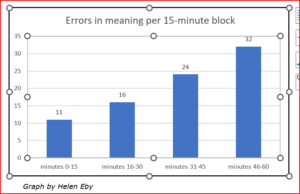Onsite Simultaneous Interpretation Checklist for Spoken Languages
Team interpreting

To preserve accuracy and prevent interpreter fatigue, a team of at least two interpreters is needed for each language pair (e.g., English<>Spanish, English<>Somali). A study conducted by Moser-Mercer et al. shows that errors in meaning committed by experienced conference interpreters while interpreting in the simultaneous mode begin to occur well before interpreters become aware of them. As shown in the table below, the error rate increases over time. This is why interpreters work in teams, switching with each other before their error rate increases.
Materials
In advance of the event, speakers should supply the following to the interpreters:
- Agenda
- PowerPoint slides
- Videos (including links)
- Reference materials such as sections from poems or books that will be read aloud.
- Ask all speakers to speak at a pace of no more than 150 words per minute. This link has useful information on the topic.
- If more than two languages are spoken, it will be necessary to do relay interpreting, which has a greater delay than regular simultaneous interpreting. Therefore, the host should notify interpreters of all languages expected to be spoken before the event starts.
Interpreter Qualifications
Interpreters should be vetted as simultaneous interpreters. In Washington State, the following credentials assess this skill:
- Court interpreting certification. Court interpreters have passed a rigorous examination in simultaneous interpreting and often use this interpreting skill in court. They can be found at this site: Washington State Courts – Court Interpreters – Court Interpreter Program
- WA DSHS LTC Social Services Interpreting, certified in Simultaneous interpretation. They can be found at this site: Find an Interpreter or Translator – LTC (wa.gov). Under credentials, search for SS Interpreter – Simultaneous.
Working conditions
- Clear visual and audio: Interpreters need to see and hear the speakers extremely clearly. Therefore, they need to sit at the front of the room, where they can face the speakers at a 90-degree angle with clear visibility of the slides projected and the speaker, unobstructed by any furniture.
- Microphones: Speakers and those asking questions and making comments should use microphones so everyone in the room can hear them clearly. If the Q&A is done in consecutive mode, interpreters should have a microphone at their table to interpret the questions from the audience. If not, interpreters will have to do chuchotage for the speakers.
- Electrical outlet: Interpreters need to be able to plug in their laptops into an electrical outlet to access their terminology resources.
- Water bottle: Interpreters carry a water bottle to keep their voice fresh.
- Table: a table with space for two laptops and other materials, water bottles, etc., must be provided to interpreters.
- Chairs: Each interpreter needs a chair. Ideally, an office chair that can be adjusted for their height and can easily move when they sit down or stand up.
Conference planning
- Teams: Figure out how many language combinations are needed (e.g., Spanish <> English, Somali <> English, Cantonese <> English) and assign two interpreters per language pair.
- Plenary sessions: Only one team per language pair is needed. Make sure that each language pair uses a different channel.
- Breakout sessions: Allow at least 30 minutes for interpreters to relocate from one room to another. Otherwise, they will arrive late, since they have to pack up their equipment after the speaker runs late, get to the next room, and set up at a new table and chairs in a new room. Alternatively, each interpreting team stays in a specific room for the entire event.
- Breakout sessions with same topic in different time slots: To use interpreter teams judiciously, only one time slot per topic should have interpretation.
Support staff
Interpreters must focus fully on the challenging task of interpreting. Therefore, others must be responsible for:
- Handing out interpreting equipment: Someone other than the interpreters should check in and check out interpreting equipment, which would otherwise distract interpreters from their work. It is common to hand out equipment in exchange for a photo ID. This ensures the return of the equipment.
- Tech support: Interpreters do not provide tech support. When members of the audience have trouble hearing, the person handing out the equipment should trouble shoot the issues. Accordingly, it is necessary to have a plan for troubleshooting and share it with the interpreters before the event starts.
- Separate channels: When interpreting is happening in more than one language or in more than one room, each language and room should be on a different channel. Equipment should be given to attendees considering the right channel for the room and language in question. Otherwise, there will be interference between the interpreting systems (static on the line).
Reference materials
- Average Speaking Rate and Words per Minute, by Virtual Speech
- Interpreters need higher quality sound than ordinary listeners, YouTube video by David Violet
- Moser-Mercer, B. Künzli, A., & Korac, M. (1998). Prolonged turns in interpreting: Effects on quality, physiological and psychological stress (Pilot study). Interpreting, 3(1), 47-64.
- Position Paper on Team Interpreting, National Association of Judiciary Interpreters and Translators.
- Tips for speakers for virtual multilingual meetings, International Association of Conference Interpreters
Simultaneous Interpretation Onsite 20230202
By Helen Eby and Milena Calderari-Waldron
February 2, 2023

